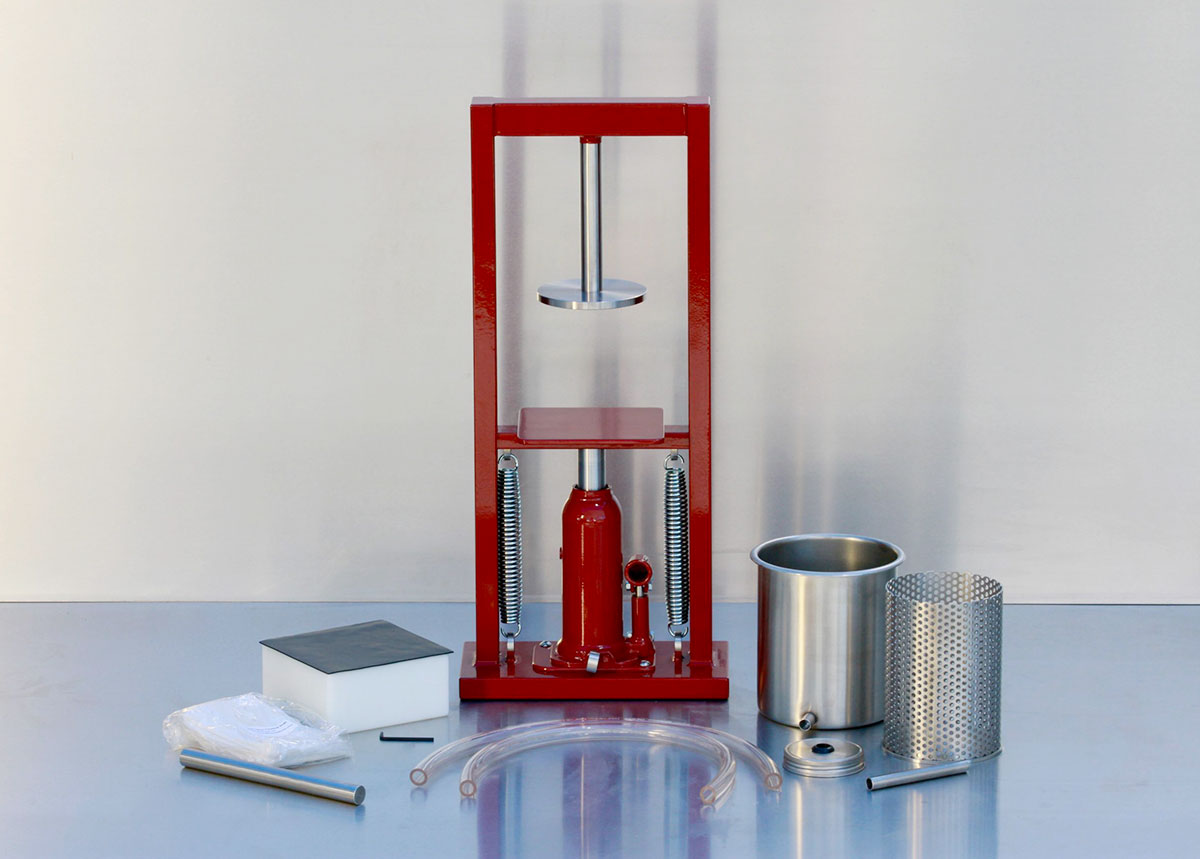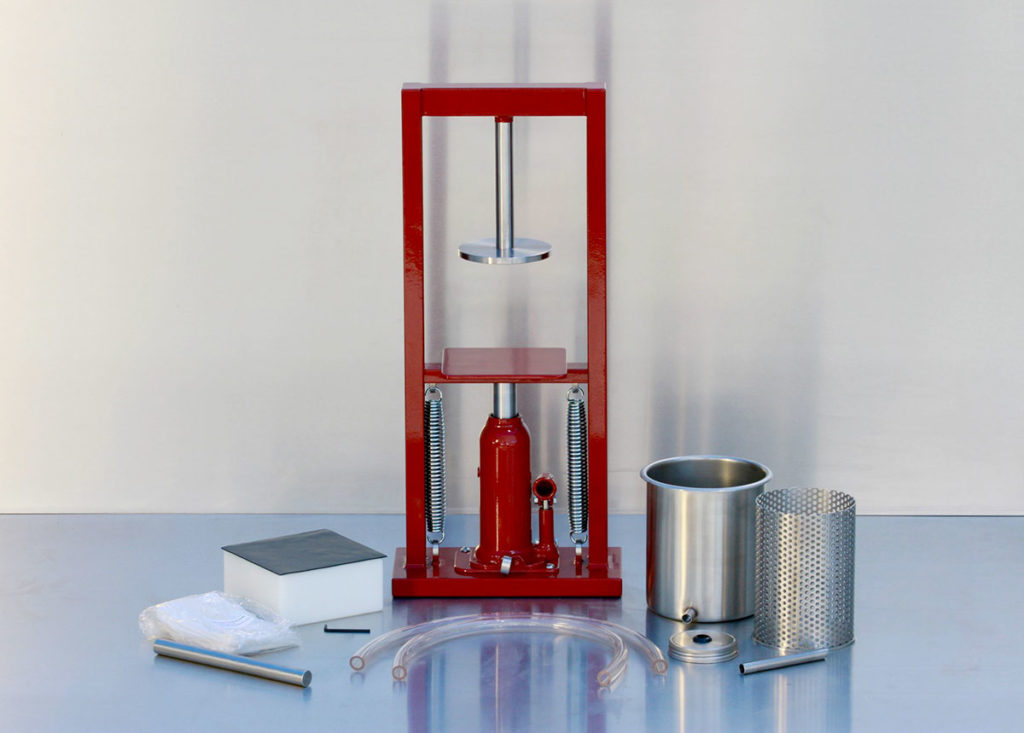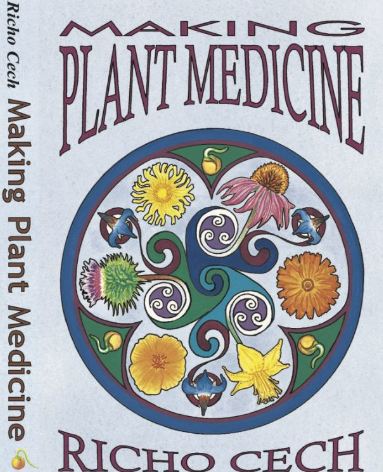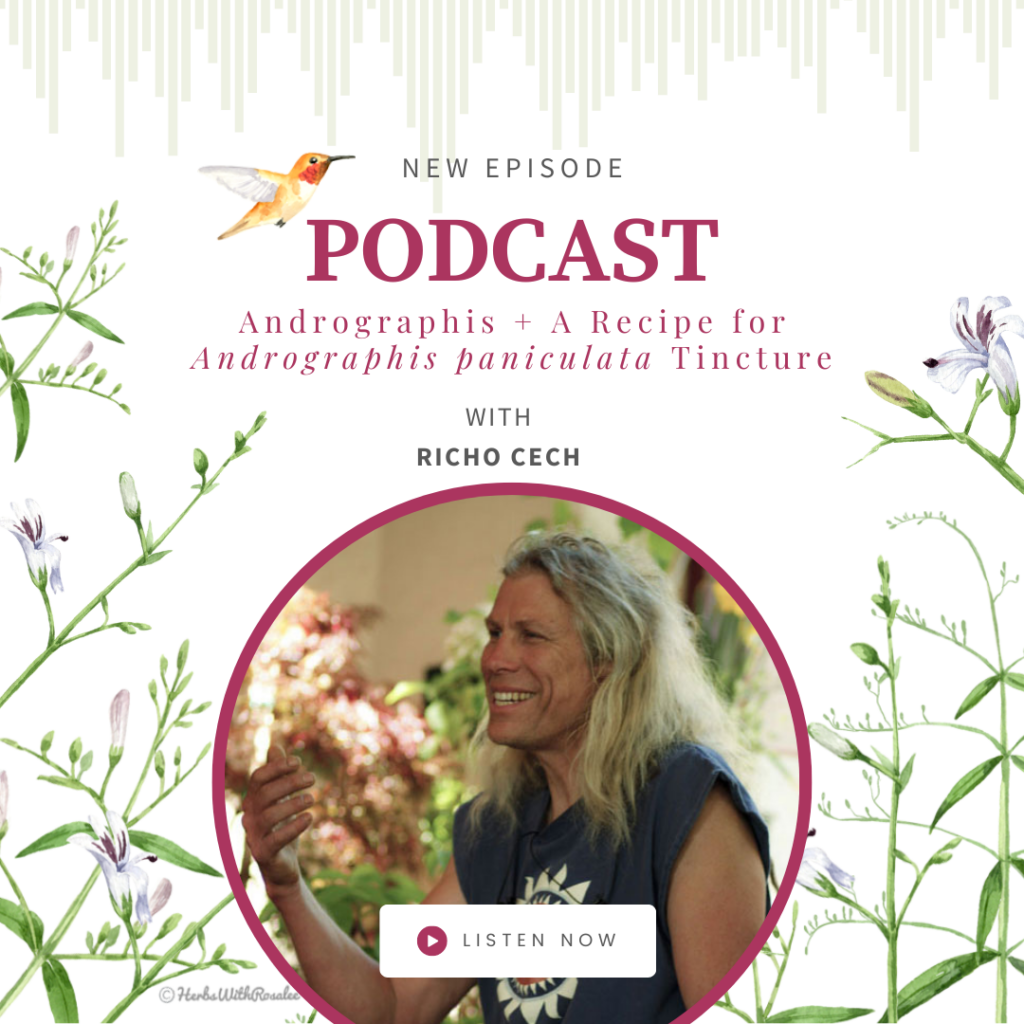
Early disasters. Pressing tinctures was my first herbal job, and I approached it quite enthusiastically, but soon realized the benefits of—finesse. The press was a handmade affair, bolted to the wall, fitted out with open pans that could be jacked together to squish a large, loaf-shaped object that was actually the macerating tincture surrounded by a carefully folded-over pressing cloth. I wanted to impress everyone with my efficiency, so I jacked away enthusiastically at the dandelion tincture. The more I jacked, the less it yielded, until suddenly, the bag split, sending a horizontal geyser of fresh, green goo out the side of the press, down the hall, finally splattering against the wall of the living room, a kind of spontaneous modern art—abstract, costly, and difficult to expunge. Lesson number 1: press slowly at low pressure to start, and only apply heavy pressure once the herbal mass has given up the majority of its liquid. I also began to envision an herbal press that had closed pans, allowing the containment of any accidental geysers.
And so, a larger press was designed, large enough to press 5 gallons of tincture at a time, fitted out with explosion-proof, cylindrical pans, a perforated basket and a 20-ton hydraulic jack. This would be the cat’s pajamas! I filled the pressing bag inside the perforated pan with macerating tincture of Echinacea root. As I jacked away, I saw that the new press worked splendidly. Fresh tincture poured out the spout into the receiving container. Eventually, the tincture stopped flowing, and I flipped the switch that was supposed to disengage the jack and let the pans back down. The platen came down all right, but the pans remained stuck to the plunger. Lesson number 2: repack the herb at least once during the pressing process to limit the possibility of stuck pans! Using a pry bar and a rubber mallet, I worked away, aiming to free the pans before the head herbalist got out of bed and came into the lab to see how things were going. That’s how he found me—prying away at his new press while striking resounding blows with a mallet. He hoped it was a bad dream, and rubbed his eyes in disbelief!
How to free a stuck press. The press bag tends to ride up around the plunger as the tincture is expressed. Keep an eye on the plunger, and if you see the pressing bag riding up, then let the press back down, remove the bag from the perforated pan, knead the contents and repack. Then, jack the press back up, and the bag will probably not ride up again. If the perforated pan gets stuck to the plunger, then let the press down, remove the press block, tip the outer pan and remove it from the press, remove the base from the perforated pan and pull the press bag down and out. If this does not work, then set the press on the floor and stand above it. Put a towel on the top of the perforated pan to cushion it (and you), and with the palms of your hands push down evenly on the top of the perforated pan. It will easily come loose. Then, put the press back on the bench, reassemble the press parts as before, repack the herb, insert the press block and press to completion.

Yield. We eventually discovered that, although it was more efficient to press out one large batch at a time, we were getting lower overall yields. Yield is a function of PSI (pounds per square inch). Even with the 20-ton jack, we were getting lower overall yields from the 5 gallon press compared with using the 6-ton jack on a ½ gallon press. This is why, when we started manufacturing presses at Strictly Medicinal Seeds, we opted for producing the smaller press. The smaller press optimizes yield. After years of production and our continuous efforts to perfect our 1/2 Gallon Strictly Medicinal Tincture Press (Lab Press), it’s now arguably the nicest mid-size tincture press on the market with a perfect balance between efficiency and yield. Our latest line also features a rainbow of colors—to better suit your needs. Watch the video below to see one in action!
How to wash the bags. If pressing multiple runs of the same batch, you don’t need to wash the press bag in between pressings. However, it is a good idea to pull the cloth out of the perforated pan, remove and compost the marc (the compressed cake of fibrous material) and give the empty bag a good shake (outdoors) before reusing. Bags should be washed between different tinctures. Immerse the bag in a basin of hot water and thoroughly agitate, then rinse three times in hot water. Do not use soap—soap will leave residues that will get into your tinctures. Bags used for pressing resinous herbs (Sage, Yerba Santa, Gumweed, etc.) should be first washed in pure grain alcohol, then washed in hot water and rinsed three times before re-use. If the bag still smells strongly like the resinous herb, then dedicate it to that herb, label it carefully, and don’t use it again until the next time you need to press out that particular herb.
How to use cheesecloth. Unbleached cheesecloth is a good choice for pressing out infused oils, resinous herbs, or extremely aromatic or pungent herbs. If you get a lot of holes in your polypropylene press bag, then consider using cheesecloth instead—it works just as well and is inexpensive. Make the cloth into a large square consisting of at least 4 layers. Push the square of cloth down into the perforated pan, pour in your macerating extract, fold the residual cloth over the top of the herb, and press as usual. Cheesecloth can be re-used or composted.
Each herb presses out a bit differently. Herbalists will find that pressing herbal tinctures is like treating people with herbs—you get along better once you understand the individual characteristics of each herb. Tinctures made of woody herbs will hold onto more residual tincture than tinctures made of leafy herbs; tinctures of fresh herbs will press more slowly than tinctures of dried herbs; mucilaginous herbs will yield only reluctantly. Herbal glycerites will press out more easily if they are warmed to 90 degrees F before pressing. Herbal oils will press more efficiently if warmed up, and generally should be pressed using 4 layers of cheesecloth instead of the polypropylene press bag. Cayenne, garlic, propolis and myrrh tincture should each be given a dedicated pressing bag, as these potent substances never really wash out, and will taint other tinctures if the pressing bag is reused. Herbal oils require excellent cleanup (hot, soapy water and at least 3 hot rinses) and a dedicated hose, otherwise subsequent batches will contain an oily residue.
Making Plant Medicine. You can learn about many different herbs used in tincturing and making other types of herbal medicine in depth in my book “Making Plant Medicine,” the 4th edition. You’ll find formulary on such important favorites as, Arnica, Astragalus, Burdock, Calendula, Dandelion, Echinacea, Elecampane, Gentian, Goldenseal, Hawthorne, Ma-huang, Jiao-gu-lan, Lobelia, Nettles, Sage, Stevia and Saint John’s Wort. The fourth edition includes 28 new herbs including Aloe vera, Andrographis, Ashitaba, Brahmi, Chameleon Plant, Hops, Osha and Rhodiola.
“Making Plant Medicine” is many herbalists’ go-to reference when it comes to making herbal medicine, both entertaining and easy to follow. It’s a must-have for anyone who’s interested in the power of plants as wellness. If you’re on a path to make potent plant medicine, get to know your herbal allies first, then let the magic begin!



after pressing when would you incorporate the alcohol?
the alcohol is added to the herbs prior to the pressing. we suggest reading the book “Making Plant Medicine” for a full go-through of how this is done
I made a tincture with 100 proof vodka and garlic. It turned green after a few weeks, then I separated the top from what fell to the bottom. Thought i was good put it back on the shelf in the cool dark. When i checked it a week later it had turned a brownish dirty water color. Is it ok or did it go bad?
Hi Greta, Thanks for staying in touch. Garlic, as you have found, acts wierd in alcoholic extracts. You get a ton of separation and precipitation from it, and it really ends up smelling like, well, not pleasant. I don’t think its probably “bad” in the sense that its rotten–the vodka will probably prohibit that–but garlic is better taken fresh or cooked. It doesn’t lend itself to tincturing. That’s why I don’t include it in “making plant medicine” richo
Thank you for your book. I have relied on it repeatedly, in spite of buying several other herbalism books. Yours is the one with the recipes I use the most! While searching online for how to use a press, I found this and was happy to see that once again, you came thru for me. Thanks for being here!
I’m wondering if you have a source that you would recommend for purchasing a 5 gallon amount of alcohol for tincturing?
yes, these folks are by far the best https://organicalcohol.com/
I made a tincture using alcohol. I hand pressed using cheese cloth. It’s settled in a jar with the sediment gathered in the bottom. It’s beneficial to separate the liquid from the sediment or use it as is?
Hi Pete, The usual wisdom on this is that the sediment is not part of the tincture and should be excluded. Its already settled, just decant the clear tincture off of the top and run the remainders through a coffee filter to get the last bit of your tincture back. Richo
Is the inulin in the settlement of echinecea and ashwaganda tinctures and do I still decant those type of tinctures? Will I loose the medicinal part if I do?
Hello Heiderose, Yes, decant and filter. The sediment is not the soluble active constituents, it is dirt. Richo
May I ask… Why use a bag ? Is it to avoid a strain after a few weeks settling ? Would it worl without the bag or too much matter would pass through the perforated cylinder ?
Thanks !
Hi Marie, The bag helps filter out fine particulates that don’t belong in an elegant tincture. If you had a very fibrous macerate like oregon grape root you might be able to get by without using the bag. richo
Have first edition signed Making Plant Medicine books. Watched the development of your tincture press and seeds collected and propagated from all over the world thru the years.
LOVE, COURAGE > wife of “edlettuce” who crossed over into that other world…